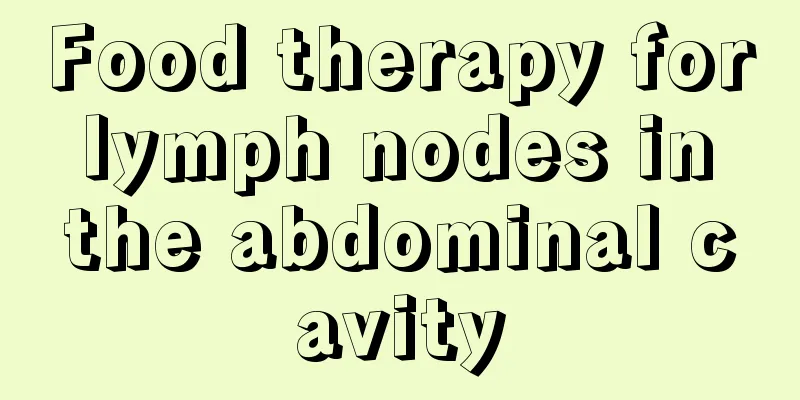What to do about chronic enteritis pain? Treat it with this kind of diet

|
Summer is also the season when enteritis is prevalent, especially chronic enteritis, which everyone should pay attention to. Chronic enteritis will cause long-term and recurring abdominal pain, indigestion, diarrhea, and in severe cases, it will cause sticky liquid stools, which can be treated through diet therapy. 1. Dietary remedies for chronic enteritis 1. Soups and porridges are the best for nourishing the stomach and intestines, so for chronic enteritis, you can choose the following therapeutic porridge. Use 60 grams of raw yam, 60 grams of raw coix seeds, 20 grams of dried persimmons, and 15 grams of lentils to cook the porridge. When making it, first cook the coix seeds until they are well cooked, then add other ingredients, add seasoning after they are cooked, and it can be eaten twice a day. 2. For patients with chronic enteritis of damp-heat type, it is best to choose 30-45 grams of fresh wet bamboo leaves, 45-60 grams of gypsum, 15 grams of lentils, 1 lotus root, and 100 grams of polished rice, and cook them together into porridge for consumption. Take 2 to 3 times a day. It is especially effective for chronic enteritis caused by damp-heat and persistent diarrhea. 3. Finally, some soup and dietary therapy recipes are also effective in treating chronic enteritis. For example, you can use 60-90 grams of purslane and 10-12 grams of lentil flowers. Put appropriate amount of water and boil it together, then add brown sugar. Take one dose per day, twice a day. Or use 15 grams of Plantain seeds, boil it into a soup and drink it instead of tea. It is also effective in preventing and treating chronic enteritis. 2. Symptoms of chronic enteritis. 1. Clinical manifestations include long-term chronic or recurrent abdominal pain, diarrhea, indigestion, etc. In severe cases, there may be mucus or watery stools. The severity of diarrhea varies. In mild cases, patients may have bowel movements 3 to 4 times a day, or diarrhea and constipation may occur alternately; in severe cases, patients may have bowel movements every 1 to 2 hours, and may even suffer from fecal incontinence. Some patients may have nocturnal diarrhea and/or postprandial diarrhea. When the rectum is severely affected, a feeling of tenesmus may occur. The feces are mostly paste-like, mixed with a large amount of mucus, and often contain pus and blood. 2. The initial manifestations of chronic ulcerative colitis can take many forms. Bloody diarrhea is the most common early symptom. Other symptoms include abdominal pain, bloody stools, weight loss, tenesmus, vomiting, etc. Occasionally, the main manifestations are arthritis, iridocyclitis, liver dysfunction, and skin lesions. Fever is a relatively uncommon sign; in most patients the disease is chronic and low-grade, but in a minority (about 15%) it is acute and catastrophic. These patients present with frequent bloody stools, up to 30 times a day, as well as high fever and abdominal pain. |
<<: What causes dry mouth and sore throat? What to do?
>>: What are the early symptoms of chronic enteritis?
Recommend
How to adjust diet after lung cancer surgery? Diet adjustment plan for lung cancer patients after surgery
For lung cancer patients, many patients choose su...
What's the matter with blood streaks on nails
When it comes to nails, people may not pay much a...
The stool is extremely dry and can't be passed
There are several types of dry stool. For mild dr...
What are some tips for pregnancy testing?
If women feel that they might be pregnant, they m...
Mid-term treatment costs for esophageal cancer
Surgery is the main treatment for esophageal canc...
How long does it take for acne on the face to heal
When we reach puberty, many pimples will appear o...
What’s the matter with a small lump of flesh growing on my buttocks?
Our human body can be said to be a sophisticated ...
What are the early symptoms of colorectal cancer
People in life always have troubles, so diseases ...
What is the order of swimming, sweat steaming and bathing
Sweat steaming can not only achieve the effect of...
What causes back pain?
When back pain occurs, we should not blindly use ...
Hazards of iohexol contrast agent
Iohexol contrast agent is a type of contrast agen...
What should I pay attention to when using diapers for my baby girl?
When parents buy diapers, they must consider the ...
What should I do if I feel bloated after eating?
Some people feel bloated in their stomachs after ...
How to treat corns in the early stage by yourself
Corns are not a very serious disease, but once th...
What are the common treatments for lung cancer? Some treatment suggestions from lung cancer treatment experts
What are the common treatments for lung cancer? L...









